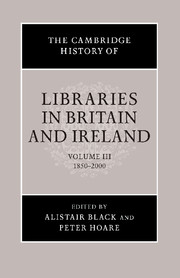Book contents
- Frontmatter
- Introduction: sources and methodologies for the history of libraries in the modern era
- 1 Libraries and the modern world
- Part One Enlightening the Masses: the Public Library as Concept and Reality
- Part Two The Voluntary Ethic: Libraries of our Own
- Part Three Libraries for National Needs: Library Provision in the Public Sphere in the Countries of the British Isles
- Part Four The Nation's Treasury: Britain's National Library as Concept and Reality
- Part Five The Spirit of Enquiry: Higher Education and Libraries
- 26 Introduction: Higher education and libraries
- 27 The libraries of the ancient universities to the 1960s
- 28 The libraries of the University of London to the 1960s
- 29 The Civic universities and their libraries
- 30 Academic libraries and the expansion of higher education since the 1960s
- Part Six The Rise of Professional Society: Libraries for Specialist Areas
- Part Seven The Trade and its Tools: Librarians and Libraries in Action
- Part Eight Automation Pasts, Electronic Futures: the Digital Revolution
- Bibliography
- Index
- References
30 - Academic libraries and the expansion of higher education since the 1960s
from Part Five - The Spirit of Enquiry: Higher Education and Libraries
Published online by Cambridge University Press: 28 March 2008
- Frontmatter
- Introduction: sources and methodologies for the history of libraries in the modern era
- 1 Libraries and the modern world
- Part One Enlightening the Masses: the Public Library as Concept and Reality
- Part Two The Voluntary Ethic: Libraries of our Own
- Part Three Libraries for National Needs: Library Provision in the Public Sphere in the Countries of the British Isles
- Part Four The Nation's Treasury: Britain's National Library as Concept and Reality
- Part Five The Spirit of Enquiry: Higher Education and Libraries
- 26 Introduction: Higher education and libraries
- 27 The libraries of the ancient universities to the 1960s
- 28 The libraries of the University of London to the 1960s
- 29 The Civic universities and their libraries
- 30 Academic libraries and the expansion of higher education since the 1960s
- Part Six The Rise of Professional Society: Libraries for Specialist Areas
- Part Seven The Trade and its Tools: Librarians and Libraries in Action
- Part Eight Automation Pasts, Electronic Futures: the Digital Revolution
- Bibliography
- Index
- References
Summary
Introduction
There are two broad approaches to the writing of history: thematic or narrative. The former may allow for a more rigorous analysis, while the latter permits a more even flow and an easier understanding of the broad picture. The more contemporary the history, the more difficult it becomes to be objective: to see issues in their proper perspective or to give due weight to one aspect of life against another in the continuous flow of development. With that in mind, this chapter will look at the issues thematically. If objectivity is difficult for events through which one has lived, it is all the more difficult when the writer has been a participant, even if in a minor fashion, in many of the events to be related. While an attempt has been made in this chapter to present a balanced review, there can be little doubt that partisan opinions will, from time to time, have broken through. It is to be hoped that this will help to enliven the discourse, rather than distorting the reality.
The year of the Robbins Report is taken as the starting point for this chapter as the report is often represented as being the beginning of the development of mass education in this country. It was, of course, no such thing. There was a significant growth in the numbers of students in the post-war period before Robbins, with a 46% growth from 1953 to 1963. Even by 1973, ten years after Robbins, the number had risen only to 239,000, although this represented more than 100% growth during the previous decade.
- Type
- Chapter
- Information
- The Cambridge History of Libraries in Britain and Ireland , pp. 377 - 402Publisher: Cambridge University PressPrint publication year: 2006
References
- 2
- Cited by



